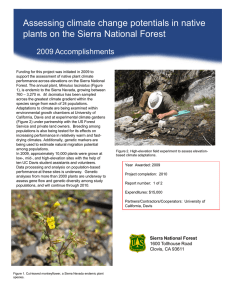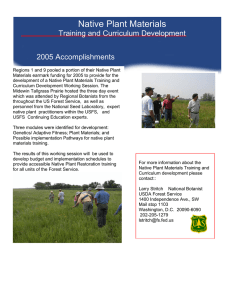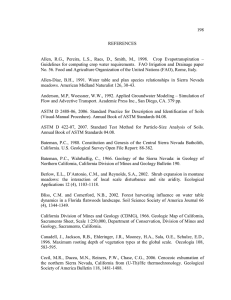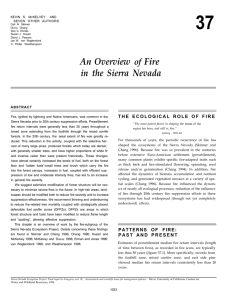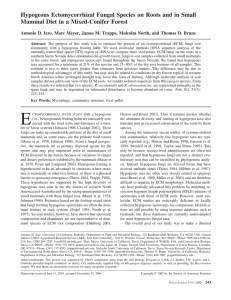Climate Research in Western Mountains A Future Agenda
advertisement
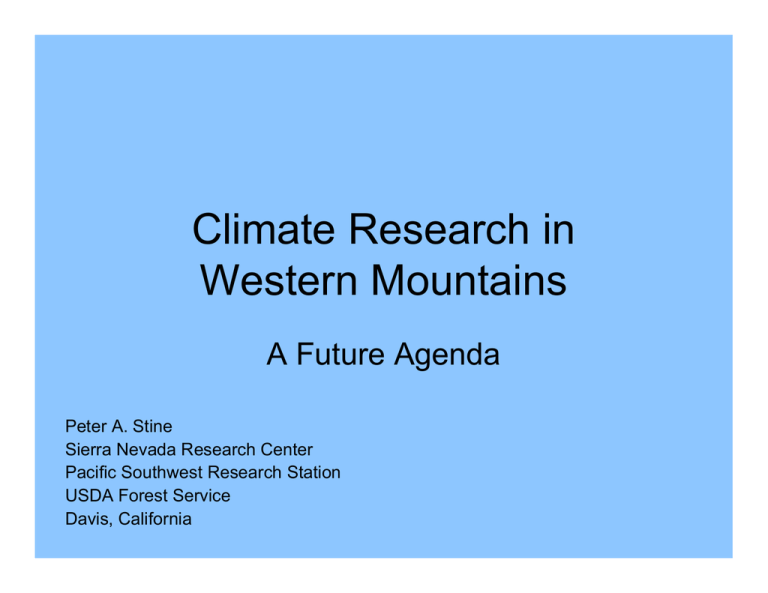
Climate Research in Western Mountains A Future Agenda Peter A. Stine Sierra Nevada Research Center Pacific Southwest Research Station USDA Forest Service Davis, California The Consortium • • • • • • Exciting assemblage of scientific expertise Enthusiasm Relevance Importance Opportunities Collaboration has been impressive Data • • • • Massive amounts Grand spatial and temporal scales Multi-disciplinary sources and needs Complex relationships Basic Research • The building blocks of our understanding • What we are trained to do; how we are rewarded • Climate change deals with complex relationships, multi-disciplinary problems • Obviously there are tremendous resource management implications Some Significant Findings • Changes in the hydrological cycle – Snow decreases in proportion of total precip – Earlier snowmelt • Snowpack is critical to groundwater recharge • Local processes will have a meaningful influence on how global climate change translates into local conditions (think globally, act locally) • Temperature is a strong predictor of how much area will burn in subsequent season Needed Research Emphases • Ecological response to near term climate change (especially at a landscape scale) – Vegetation has endured climate change in the past, how much “disruption” to the system should we expect in this next period of change? • Sierra Nevada Climate Change Assessment Project • Relative role of fire suppression activities and climate change in influencing fire severity and extent • How will exotic flora exacerbate ecological response to near term climate change? Promote Coordination • Many related activities on behalf of various organizations • Overlap in purpose • Some efforts have developed significant progress • Capitalize on efforts, data, activities • E.g. USGS, USFS, NEON, etc. Causes of Climate Change • • • • Scientifically intriguing Anthropogenic? Natural cycles? Regardless, global society must cope Can society mitigate or influence climate change, particularly that caused by activities of humans? Public Relations • The message of doom strikes fear • The limited ability to respond, especially without significant societal adjustments, not the least of which is economic, invokes fear • Fear is met with denial or rejection • So don’t ignore the ramifications but offer means to cope, solutions Beyond Research • We need to do more; expand beyond our typical limits of activities and expertise • Collaboration should include educators, outreach specialists, editors, journalists Sierra Nevada Forest Plan Amendment • U.S. Forest Service land management direction • 2001 and revised 2004 Decisions • No mention of climate change or any reference to how land managers will cope • What would they do with the information we currently have? • What will they have to work with in 5 years? New Objectives • Future activities of CIRMOUNT should have innovative and new aspirations • Meetings/activities could include: – collaborations to produce text books – workshops to produce outreach materials – find opportunities to find out what managers need to know; engage managers • Find logical industry partners in the mission of CIRMOUNT (water managers, ski resorts) Demonstration Projects • “Adopt a Forest” or Park or watershed • Work with managers to draw all of our insights to date to apply to a given place • If CIRMOUNT scientists were managing the Forest or Park what considerations would you make to cope with near term (e.g. 5-30 years) climate change? Other Possible initiatives for CIRMOUNT • Develop a project directed at communicating “information that can be put to work” • Synthesize what we currently know; a set of basic relevant findings • Disclose what we do not know, coordinate research agenda • Acknowledge uncertainty and disagreement • Target different audiences (managers, policymakers, public) Self-Examination of the Scientific Evidence • Is the relevant scientific information considered? • Is the scientific information reasonably interpreted and accurately presented? • Are the uncertainties associated with the relevant scientific information acknowledged and documented? • Are the relevant management consequences identified and documented, including associated risks and uncertainties?

